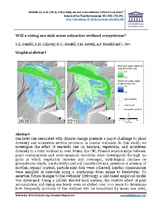Will a rising sea sink some estuarine wetland ecosystems?
Date
2016Author
Callaway, R.M.
Bertelli, C.M.
Mendzil, A.F.
Tew, I.
Grenfell, Suzanne
Grenfell, Michael
Metadata
Show full item recordAbstract
Sea-level rise associatedwith climate change presents amajor challenge to plant diversity and ecosystemservice
provision in coastal wetlands. In this study,we investigate the effect of sea-level rise on benthos, vegetation, and
ecosystem diversity in a tidal wetland in westWales, the UK. Present relationships between plant communities
and environmental variableswere investigated through 50 plots atwhich vegetation (species and coverage), hydrological
(surface or groundwater depth, conductivity) and soil (matrix chroma, presence or absence ofmottles,
organic content, particle size) data were collected. Benthic communities were sampled at intervals along a continuum
from saline to freshwater. To ascertain future changes to the wetlands' hydrology, a GIS-based empirical
model was developed. Using a LiDAR derived land surface, the relative effect of peat accumulation and rising sea
levels were modelled over 200 years to determine how frequently portions of the wetland will be inundated by
mean sea level, mean high water spring and mean high water neap conditions. The model takes into account
changing extents of peat accumulation as hydrological conditions alter.
Model results show that changes to the wetland hydrology will initially be slow. However, changes in frequency
and extent of inundation reach a tipping point 125 to 175 years from2010 due to the extremely low slope of the
wetland. From then onwards, large portions of the wetland become flooded at every flood tide and saltwater intrusion
becomes more common. This will result in a reduction in marsh biodiversity with plant communities
switching toward less diverse and occasionally monospecific communities that are more salt tolerant.

